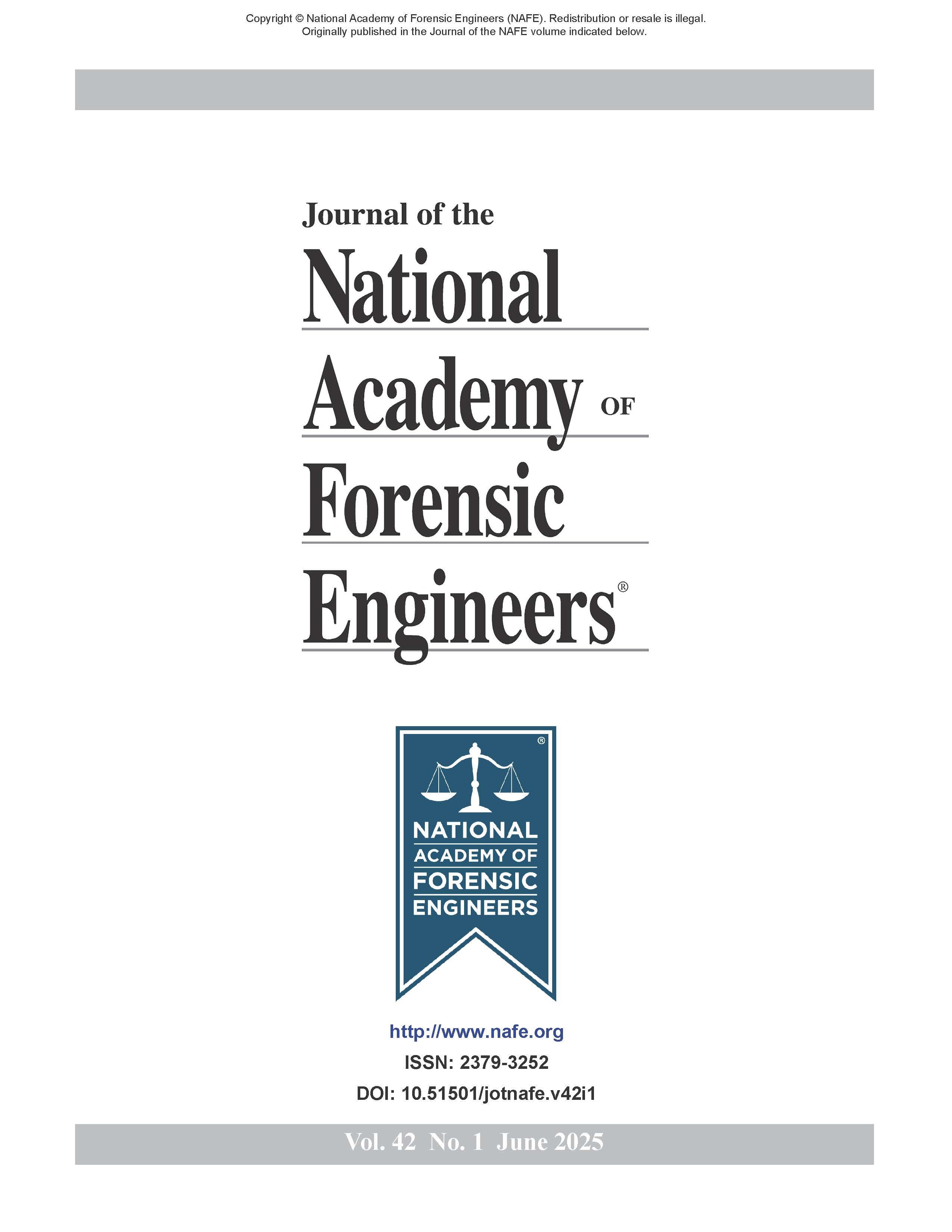FE Analysis of a Modular Fireplace Fire with an Improperly Constructed Hearth Extension
DOI:
https://doi.org/10.51501/jotnafe.v42i1.970Keywords:
Modular fireplace, hearth extension, wood burning, chimney, low temperature ignition, smoldering, clearances, fire investigation, methodology, reconstruction, testing, chase, heat transfer, NFPA 921, NFPA 211, UL 127, International Residential Code, IRC, combustible concealed space, conduction, convection, radiant, forensic engineeringAbstract
A fire originated beneath a modular fireplace hearth in a newly constructed home, which then spread into the adjacent chase and attic spaces, resulting in the destruction of the residence. The fireplace was installed on a CMU block riser positioned on a wooden subfloor in violation of the manufacturer’s installation instructions. Scene investigators concluded based on fire patterns and witness observations that the fire originated beneath the fireplace hearth and that the first fuel ignited was wood construction in proximity to the hearth. The author was contacted 3.5 years after the fire during ongoing litigation to review and analyze the available information and determine the cause of the fire. This paper examines the cause of the fire based on forensic engineering analysis and testing. Incorporation of analysis of previous similar cases and testing data as well as new testing data are utilized to reinforce the author’s cause determination.
References
J. Tindal, “Forensic engineering analysis of modular woodburning fireplace fire with gas log lighter in determining fire’s cause,” Journal of the National Academy of Forensic Engineers, vol. 38, no. 2, pp. 33-52, Dec. 2021.
Guide to Thermal Properties of Concrete and Masonry Systems, ACI/TMS 122R-14, Farmington Hills, MI: American Concrete Institute, 2014.
Amerimix, “Mortar Types: Know Your Mix,” Amerimix Technical Documents. [Online]. Available: https://tinyurl.com/mrxfkj34. [Accessed: Oct. 14, 2024].
Lignacite, “An Introduction to Dense Concrete Blocks: Their Properties, Benefits and Uses.” [Online]. Available: https://tinyurl.com/5h54vtpw. [Accessed: Oct. 14, 2024].
Lignacite, “The Thermal Performance of Concrete: An Introduction.” [Online]. Available: https://tinyurl.com/2ps669xk. [Accessed: Oct. 14, 2024].
Sakrete, “Mortar Mix Type S data sheet.” [Online]. Available: https://tinyurl.com/yh6jvk98. [Accessed: Oct. 14, 2024].
Carmelo, “Carmelo Mix Type S data sheet.” [Online]. Available: https://tinyurl.com/3vdvw8ec. [Accessed: Oct. 14, 2024].
J. P. Holman, Heat Transfer, 7th ed. New York, NY, USA: McGraw-Hill, Inc., 1990.
D. J. Icove and G. A. Haynes, Kirk’s Fire Investigation, 8th ed. New York, NY, USA: Pearson, 2018.
UL 127 Standard for Factory-Built Fireplaces, Northbrook, IL: Underwriters Laboratories, 2015.
V. Babrauskas, B. Gray, and M. Janssens, “Prudent Practices for the Design and Installation of Heat-Producing Devices Near Wood Materials,” Fire Mater, no. 31, pp. 125-135, 2007.
J. Tindal and J. Warren, “Forensic engineering analysis of low temperature ignition of wood,” Journal of the National Academy of Forensic Engineers, vol. 26, no. 1, pp. 85-103, Jun. 2009.
International Residential Code, ICC, Club Hills, IL, 2015.
Hearth Design Specialist, 1st ed. Arlington, VA: National Fireplace Institute and Hearth, Patio and Barbecue Educational Foundation, 2020.
International Residential Code Commentary, ICC, Club Hills, IL, 2015.
International Building Code Commentary, ICC, Club Hills, IL, 2009.
Standard for Chimneys, Fireplaces, Vents, and Solid Fuel-Burning Appliances, NFPA 211, 2019.
Guide for Fire and Explosion Investigations, NFPA 921, 2024.
J. D. DeHaan and D. J. Icove, Kirk’s Fire Investigation, 7th ed. New York, NY, USA: Pearson, 2012.
V. Babrauskas, “Ignition of Wood: A Review of the State of the Art,” Interflam, pp. 71-88, 2001.
Additional Files
Published
How to Cite
Issue
Section
License
Copyright (c) 2025 Journal of the National Academy of Forensic Engineers

This work is licensed under a Creative Commons Attribution-NoDerivatives 4.0 International License.
All rights © Journal of the National Academy of Forensic Engineers.
Full statement regarding the author's license of copyright to the NAFE is shown on the Copyright section of the Submissions Page.






